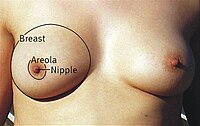
Photo from wikipedia
Breast implants are surgically implanted by the hundreds of thousands every year worldwide for reconstructive or aesthetic purposes. Complications related to breast implants include early and late effusions that are… Click to show full abstract
Breast implants are surgically implanted by the hundreds of thousands every year worldwide for reconstructive or aesthetic purposes. Complications related to breast implants include early and late effusions that are often submitted for cytopathological analysis, particularly to exclude the possibility of breast implant–associated anaplastic large cell lymphoma (BIA‐ALCL), a rare disease that generally follows an indolent clinical course, although it is becoming clearer that a subset of patients with adverse features have a poorer prognosis. Since a late‐onset breast implant–associated effusion is the most common initial presentation of BIA‐ALCL, cytopathological analysis of these effusions is considered the cornerstone and gold standard for rapid, efficient, reliable diagnosis and is critical for appropriate management and treatment. The National Comprehensive Cancer Network recently published clinical guidelines for the diagnosis and management of BIA‐ALCL and stresses the essential role of cytopathological analysis, although it remains a matter of debate if all seromas should undergo immunocytochemistry or flow cytometry, particularly for assessment of expression of CD30 irrespective of morphological appearance on cytology. Herein, we review the current knowledge on BIA‐ALCL, review the key cytological findings of reactive and malignant effusions related to breast implants, and present a comprehensive cytopathological workup with the presence of atypical cells as the key and pivotal element triggering further ancillary studies. We believe this approach will ensure appropriate and cost‐effective management of effusion specimens from breast implants.
Journal Title: Cancer Cytopathology
Year Published: 2020
Link to full text (if available)
Share on Social Media: Sign Up to like & get
recommendations!